It was barely 10 a.m. as Gerry Quinton sat critiquing the complicated lace pattern of a deep grey corset. Hair perfectly curled, dress pressed, shoes shined, she stared at what would, eventually, become another finished custom commission. A gentle knock at the door distracted her from thought, slowly redirecting her gaze towards the large glass windows lining the storefront.
Logan Square was still quiet as the sun bled in, illuminating the satin and lace hanging from the shop’s dress forms and garment racks. Department of Curiosities was officially open, but Quinton was in no rush.
Home to Morúa Corsetry & Couture, Quinton’s handmade corset company, and Production Mode, a leather goods line by Quinton’s partner Jamie Hayes, Department of Curiosities acts as part showroom and part workshop for both ladies’ designs. Originally intended to be nothing beyond a shared studio space, the shop has become home-base for the eponymous “slow fashion” lingerie line inspired by the romance and grace of the 1920s and 30s.
The vintage fireplace (refinished by Quinton and Hayes themselves), the elaborately tiled ceiling (sourced from estate sales and online bidding wars), the live exotic plants – all speak to Quinton’s demeanor. Quiet, poised and crafty, she designs and sews delicate pajamas, knickers, dressing gowns and corsets known for their smooth, precise lines. She aims to create graceful accentuations of the body, working with the client rather than an idealized template of the female form.

A Warner Brothers Corsets advertisement from 1878 detailing the health benefits of the company’s products: Originally published in a 1878 issue of the Staunton Spectator of Staunton, Virginia.
The daughter of a Costa Rican immigrant, Quinton grew up exploring her Central American heritage from her family’s home in rural Illinois. Originally an English major at a downstate Illinois college, Quinton left early to pursue her true passion. Eventually finding her way to Chicago, she applied to study fashion design at Columbia College.
“I think it often, but I truly am influenced by a sense of displacement and nostalgia,” Quinton says.
A little over a decade later, Quinton and her husband moved to London, where she began the process of creating custom corsets and other tailored-wear. After studying the antique corsets in the archives of Symington Collection, with the Museum of London and working part-time as a pattern-maker, she opened her North London studio to customers looking for one-of-a-kind pieces.
By 2014, Quinton was back in Chicago, working alongside Hayes to make Department of Curiosities a reality.
She makes every moment special and really embraces the process of making. The ambiance is stunning and the care she takes in fitting is so tailored. A true haute couture experience.” – Miss Tosh
Suddenly, the classical Cuban jazz flitting through the shop halted as the vinyl record’s A-side came to a close. Still unbothered, Quinton flipped the disc, offering espresso in her wake. The fragile tea set she produces is delicate and trimmed in gold, reminiscent of the corsets she is now recognized for.
Her attention to detail and beauty is evident, and she is careful and composed with a laugh that lights up the room. Quinton designs under the assumption that her pieces should play with the body, unlike a piece of armor. Her corsets bring out the best parts of the people they dress.
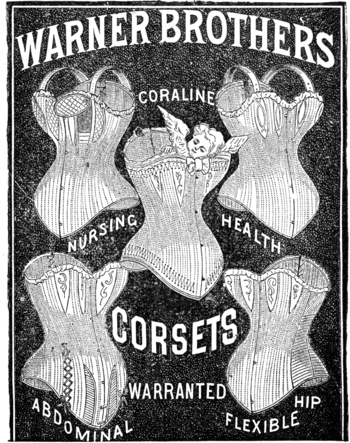
Another Warner Brothers Corsets advertisement from the late 1800s showing multiple variations in design for adaptable purposes: Courtesy of Wikisource’s Warner Brothers Coraline Corsets page.
A corset is traditionally defined as a fitted, sleeveless undergarment extending from or below the bust, down over the hipline worn by women for support and figure shaping. They are stiffened with materials such as steel and whalebone, usually tightened by lacing. Formally called “stays” prior to the 19th century, the corset is one of the oldest fashion pieces that has continued to resurface and adapt over time to fit modern-day trends.
Quinton does more than just create beautiful and ethically made fashion items. Men and women alike come to the designer to commission corsets created to help their back pain. Doctors often recommend corsets to those who had problems with their spine. In many cases, Quinton believes that her corsets are significantly more effective than medicine or traditional back braces. The corsets are created with range of thicknesses and vary in sturdiness, catering to customers’ personal styles and comfort preferences.
“The idea of a man wearing a corset struck many people as truly ludicrous,” says Valerie Steele, author of The Corset: A Cultural History. “However, military men, cavalry officers and men today favor them for back support. There are wonderful health benefits. Some men use them for posture and some even use them to aid in their dieting and appearance,” she writes.
Jessica Pushor, the costume and textile collection manager at the Chicago History Museum, elaborates: “Beginning in the mid 1800s, stores like Marshall Fields were major importers of corsets. The corsets came from Europe and were distributed to other American cities, and then into Chicago. Towards the turn of the 20th century, many companies began to manufacture the garments themselves.”
Early theories in orthopedics suggest that corsets were worn as early as the 1500s, due to the straight, conical line of women’s backs in old Venetian portraits. However, throughout the rise of women’s liberation beginning around the time of World War I, women began to wear dresses without corsets. Corsets were still worn here and there, but towards the 1950s, they were replaced with an elastic girdle.
When the “flower power” movement of the 1960s hit, women preferred to wear clothing without even girdles. Later, corsets made a comeback as a fashion trend in the 1980s with Madonna and have continued to be worn by themselves in the present day, either as exposed clothing or for their health benefits.
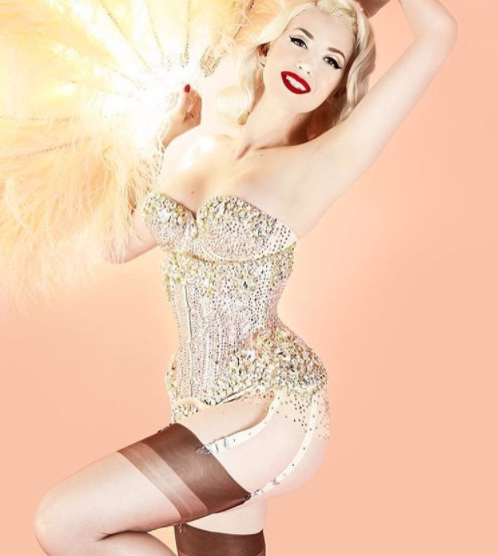
Burlesque performer Miss Tosh poses in her signature corset, designed and sewn by Gerry Quinton: Photo by Miss Missy Photo, courtesy of Miss Tosh.
A lifelong fan and friend, Miss Tosh – a burlesque performer with shows around the world – commissioned her signature corset from Quinton in 2016. As a designer, an entertainer and an LGBTQ “Glambassador,” Miss Tosh has built a professional and personal partnership with Quinton and loves their long-distance phone calls.
“If you can dream it, you can create it,” Miss Tosh says. “[Gerry and I] are definitely kindred spirits. We both just have these grand fantasies and share a childlike optimism that anything is possible.”
Miss Tosh’s haute couture burlesque performances are now recognized by the corset she created with Quinton, which is adorned with hundreds of thousands of Swarovski crystals. After a series of phone conversations and emails, Tosh flew in for a fitting at Quinton’s quaint Logan Square atelier, where she felt an immediate connection with the designer.
“We first created a corset and brassiere for my signature Carousel Unicorn performance,” Miss Tosh says. “The piece is a stunning ballet satin corset with beautiful lines and shape. She laced me in my corset for the first time when I debuted the costume during the [School of the Art Institute of Chicago] SAIC 150th year anniversary.”
The two recently debuted Quinton and Hayes’ lingerie collection for the Department of Curiosities in Los Angeles, with Tosh modeling and performing. They plan to hold two more Soirées this summer together in Chicago and London.
“I feel embraced by the corset and all the stories it now holds. [Quinton’s] pieces carry so much love and magic that they can’t help but radiate on stage.”
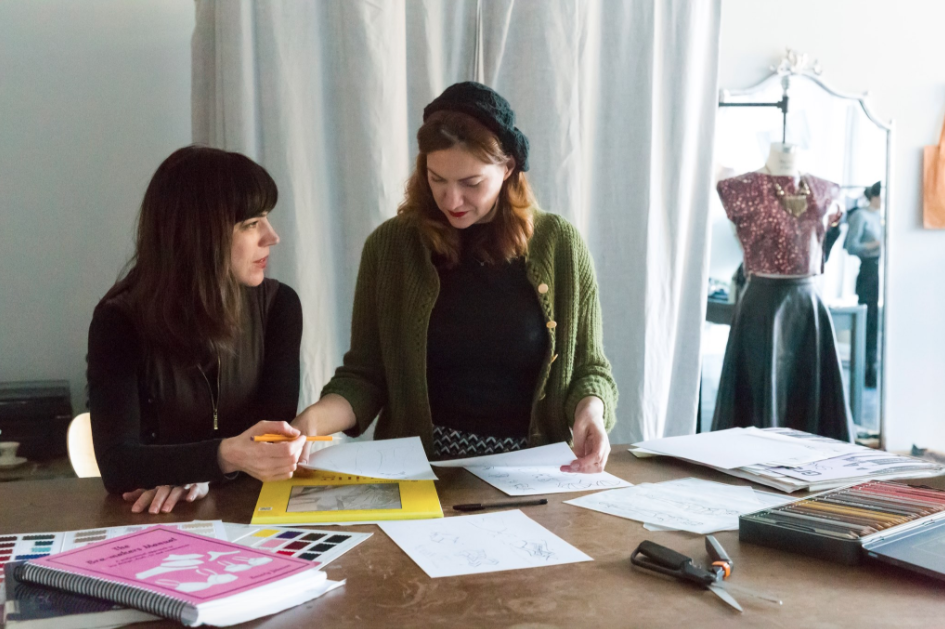
Gerry Quinton and Jamie Hayes review designs at Department of Curiosities in Logan Square: Photo by Fashion Frank, courtesy of Gerry Quinton.
Slow fashion, Quinton and Hayes’ standard for development, is all about the maintenance of the earth and the health of the people on it. It is a revolutionary practice in the contemporary world, encouraging artists to take their time to ensure quality production, to give value to the product and to contemplate their connection with the environment.
Slow fashion adheres to several central commandments, some of which include investing in better quality materials, taking care of the machines and tools that you have, taking care of the materials and tools that you use and always asking questions.
“We focus on local and ethical modes of production, making things right in the shop with materials we have chosen ourselves from manufacturers that we know,” Quinton says. The whole shop, with its large windows and open floorplan, is meant to highlight the transparency of the process.
Esther Garcia, a tattoo artist also located in Logan Square, designed the print on Italian silk (sourced from a vetted manufacturer) used for the Department of Curiosities line. Quinton and Hayes knew that they wanted someone local to assist in the creation of the line, and both were fans of Garcia’s now-closed Butterfat Studios: a neighborhood tattoo studio known for its realistic floral pieces.
Garcia, having just returned from a trip to Costa Rica for a floral workshop, jumped at the chance to help. “After learning that [Quinton] is originally from Costa Rica, it seemed like an appropriate theme for the botanicals in the pattern,” Garcia says. “I used only photos and sketches that I had made on that trip as the source material for the fabric drawings.”
The line features one pattern in two colorways (a range of colors in which a design is available), sewn into a small collection of pieces including tap shorts, tea gowns, dressing gowns and Quinton’s famed brassieres.
“In order to have the same images in both black and white and in color, I made graphite drawings and watercolored them separately,” Garcia says. “My very talented graphic designer friend Kyle Letendre then brought the sketches and paintings together, to create that lush deep tropical print.”
With the print finished, the fabric produced, cut into pattern shapes and pieces sewn in the shop, the Department of Curiosities line was born. Now displayed on lucite tables and handmade garment racks in the front of the studio, the line has taken off with customers interested in the slow fashion movement and Garcia’s print. Even Miss Tosh has taken to the line, wearing the designs in her (decidedly glamorous) everyday life.
“Her knowledge and love for her craft is unparalleled,” says Miss Tosh. “[Quinton’s] work is what corsetry dreams are made of.”


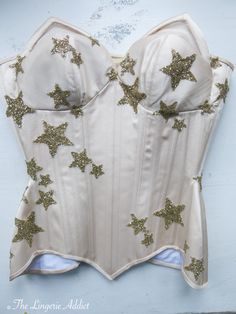

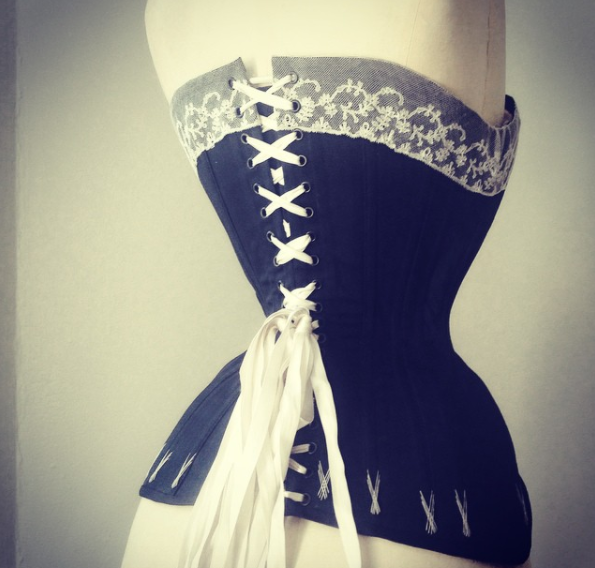
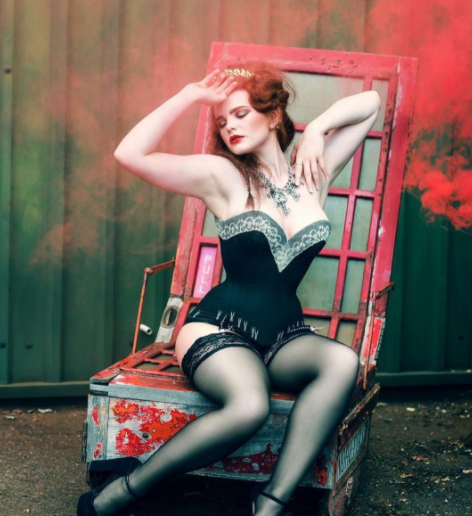


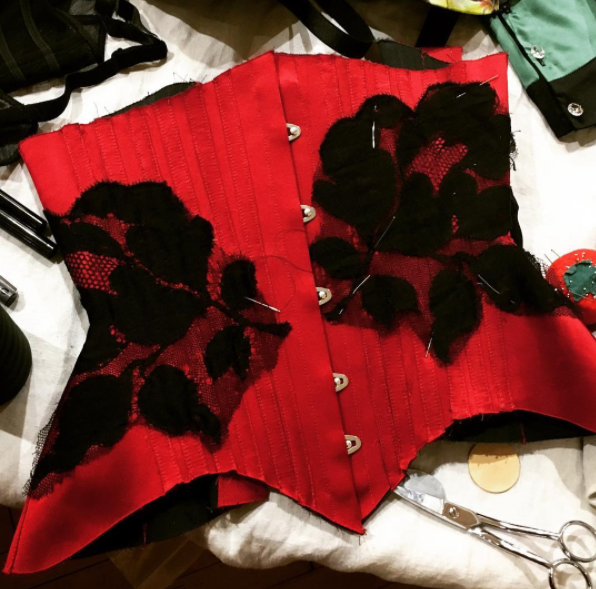



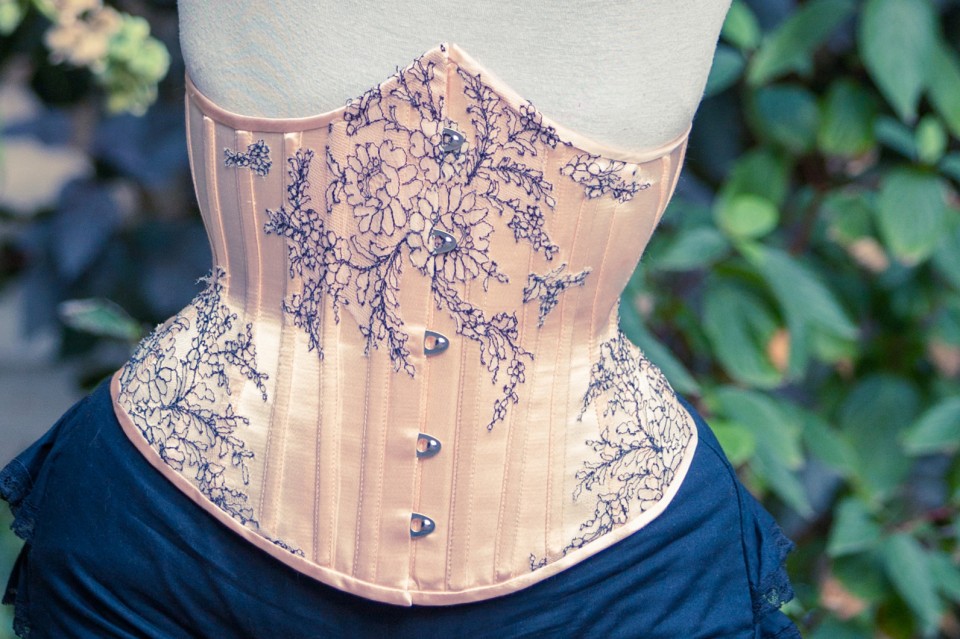

NO COMMENT